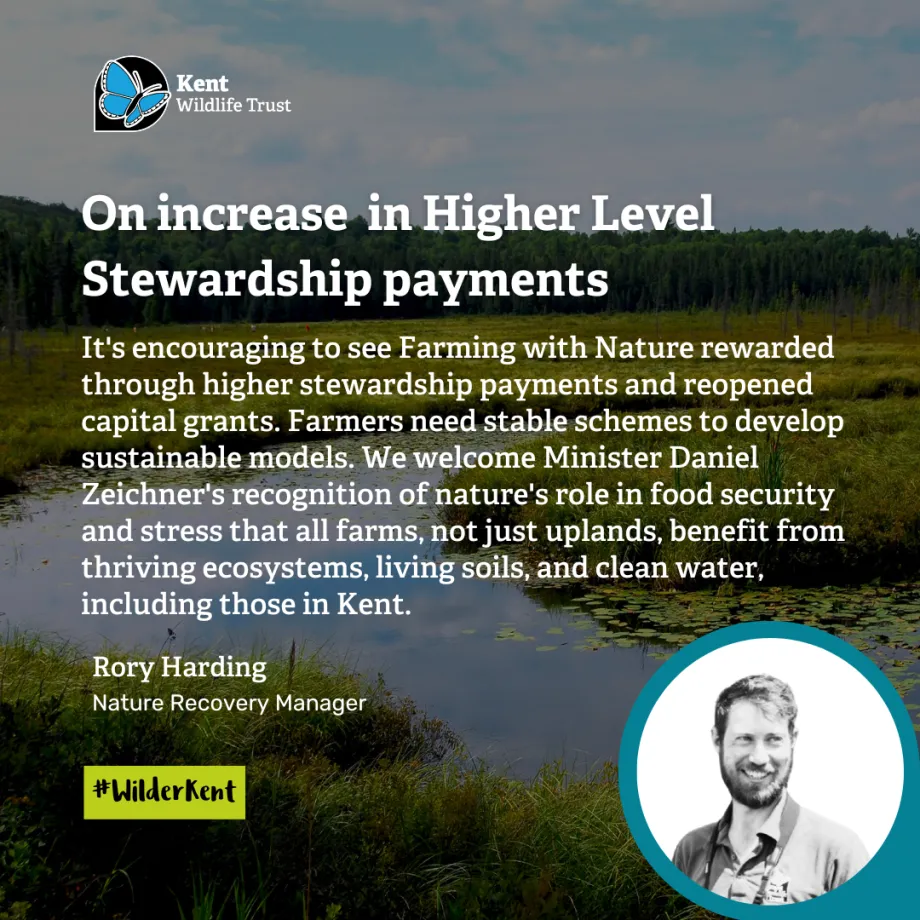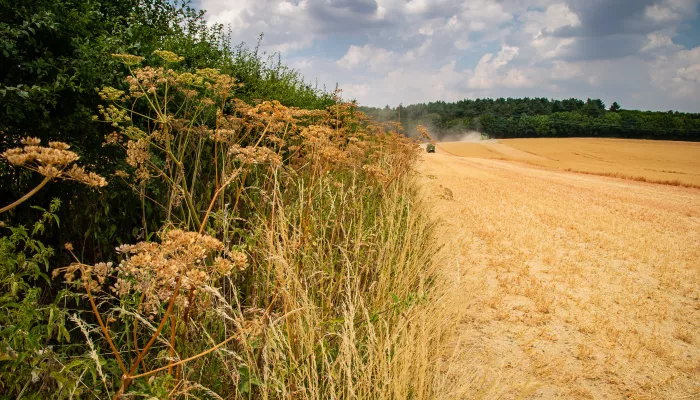Our response to the Land Use Framework consultation
Kent Wildlife Trust welcomes the opportunity to respond to the consultation on the England Land Use Framework. We recognise the ambition to balance nature recovery, climate resilience, and economic growth, but the framework must recognise - amongst its specific objectives – from the outset – that we need to put 30% of the UK’s land area into genuine nature recovery. By recognising that nature is Nationally Significant Infrastructure to deliver long-term societal resilience, this can be done.
The government has committed to international nature targets that mean doing this anyway: the 30by30 targets, which it knows it also needs to deliver its climate goals (as acknowledged in the UKs Nationally Determined Contribution (NDC). The 2030 timeline shows how crucial the Land Use Framework Consultation therefore becomes in both delivering for UK PLC and contributing to maintaining a safe operating space for humanity.
The Strategic Nature Network (SNN) is the device to enable this. It will need to overlay multiple existing land use classifications including established designations like National Parks and National Landscapes because these were not created to derive maximise nature and climate benefits. The UK needs to shift gear into one where nature is treated as a multi-decadal Nationally Significant Infrastructure Programme, through the SNN.
Strategic land use planning for maximum climate resilience
The Land Use Consultation acknowledges that England is one of the most nature-depleted countries in the world, with wildlife at risk of national extinction and our natural landscapes in poor condition. Analysis suggests that only 3% of the UK is effectively protected for nature. We must therefore us the Land Use Framework to move beyond piecemeal mitigation and no-net-loss policies into large-scale ecological restoration across 27% of our land for our collective wellbeing, societal resilience, and economic prosperity.
Currently, the Land Use Consultation only references land being "dedicated" to climate and environmental benefits but it does not suggest a mechanism for maintaining and increasing connectivity for long-term ecological recovery and maximised ecosystem services. But we have the blueprint. The SNN takes what is laid out in the Lawton Review 2010 – which informed the 25-year Environment Strategy – which in itself now needs to be updated to reflect 30by30. We need to facilitate more, bigger, better and more joined nature restoration across the UK by embedding the Strategic Nature Network into the Land Use Framework.
Embedding nature in infrastructure and land use policy
The Land Use Consultation commits to ensuring major infrastructure projects are designed and located where they cause the least disruption to nature, but there is a lack of recognition for nature as critical infrastructure itself. Nature is an asset that requires parallel investment to maximise UK PLCs climate and ecological resilience.
Nor is there recognition that doing the latter will increase resilience of supply chains e.g. through traditional linear infrastructure in a scenario where the World Economic Forum’s 2024 assessment of global risks shows that the top 5 risks are all climate and nature related, one of these being extreme weather is already impacting the UK economy, including the land-based sectors.
Whilst many policies are cross referenced including alignment with Strategic Spatial Energy Plan and Environmental Improvement Plan to ensure that nature-positive infrastructure and sustainable growth are not treated as competing objectives, there is no reference to the UK’s infrastructure strategy actively contributing to nature recovery. This counterbalance is what the integrated objective of embedding the Strategic Nature Network into the Landuse Framework can do.


Unlocking private capital responsibly
While the Land Use Consultation highlights attracting private capital for nature-based solutions, it lacks a planned and strategic approach for how land use change will be identified and implemented at a scale necessary to unlock this investment.
The UK government has a unique opportunity to harness public spending as a catalyst for private investment in nature recovery. By strategically deploying public funds, the government can de-risk early-stage projects and establish the foundations of robust nature markets.
It is therefore crucial that financial mechanisms support land managers in delivering multifunctional landscapes, ensuring that carbon sequestration, biodiversity recovery, and flood resilience are embedded within a high-integrity investment model. Without this clarity, private finance risks being deployed in ways that fail to deliver long-term and durable ecosystem benefits.
‘Natural Investment Zones’ which make up the large restoration areas within the Strategic Nature Network will serve as dynamic hubs, bringing together investors, landowners, and nature could unlock aggregated opportunities for collaboration, funding, and the large-scale impact required.
A unified, strategic vision for nature recovery
The Land Use Consultation recognises that the current fragmented approach to land use planning, driven by locally led strategies, has created inconsistencies and uncertainty for land managers.
The framework must therefore provide a more structured, joined-up vision that enables landowners to make informed decisions about how to maximise environmental, economic, and social benefits from their land. This must include clear guidance on ecosystem functionality and connectivity, strategic nature recovery, and climate resilience. All of this is captured within the concept of the Strategic Nature Network as critical Nationally Significant Infrastructure Programme.
And finally
The Land Use Framework must be more than a set of guiding principles it must drive the multi-decadal building on the UKs Strategic nature network, rebuilding large-scale nature recovery through private sector investment.
We urge the government to prioritise ecosystem functionality, nature connectivity, and long-term climate resilience as fundamental principles in land use policy to which it is already committed through its international nature and climate targets, but for which it lacks a delivery vehicle that can enable economic growth and build national resilience in changing climate to protect its citizens for generations to come.
This need for multi-faceted national strategy is why Kent Wildlife Trust are supporting Rebuilding Nature, an industry-led initiative to create a UK Strategic Nature Network by restoring dynamic ecosystems that protect society (www.rebuildingnature.com).
Evan Bowen-Jones, CE Kent Wildlife Trust
“The Land Use Framework Consultation is a once-in-a-lifetime opportunity for the government to commit to a bold positive vision for parallel economic growth and nature recovery and embed this into the geographic fabric of our nation. A coalition of land managers, financial institutions and national infrastructure delivery bodies is poised to help harness private sector investment and create a Strategic Nature Network which will make the UK economy more resilient. We urge decision-makers to seize the opportunity for transformational positive action on the environment – something that would be backed by UK citizens who are increasingly worried about their future because of extreme weather and the threats of ecological collapse. Now is the moment to make nature into Nationally Significant Infrastructure.”
Rory Harding – Nature Recovery Manager, Kent Wildlife Trust
"For centuries, farming in the UK and across our planet has been underpinned by resilient, thriving ecosystems. Where land is degraded in pursuit of short-term gains, long term food security is undermined. A land use framework for England is vitally needed to support a strategic approach to managing the competing demands on our landscape. The essential role of nature in supporting business growth and long term human health must be recognised. Nature Recovery should be woven through the framework, with regenerative farming approaches alongside wilder land management and connecting infrastructure between.
It's not farming or nature, we need Nature Recovery at scale to support farming businesses and food security into the long term. The right land use framework will support a vital strategic approach to managing this limited resource, protecting 30% of our land for restoration and incorporating regenerative farming approaches to food production. Given a chance, we know nature can bounce-back and provide multiple solutions to the challenges we face as a society."

